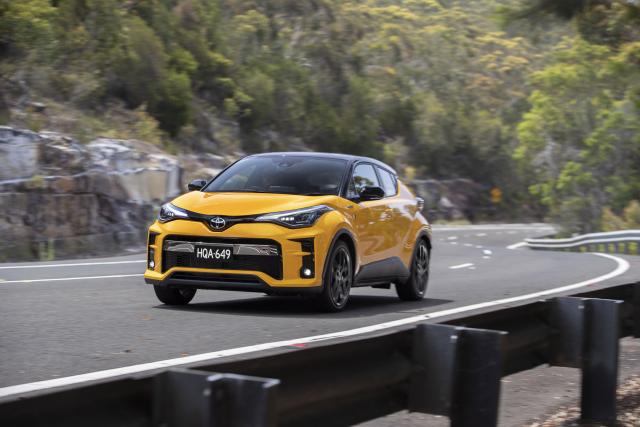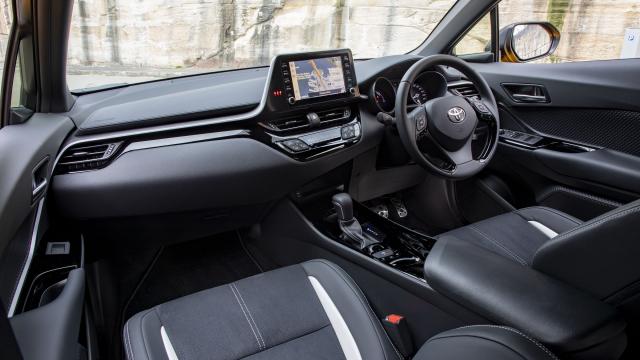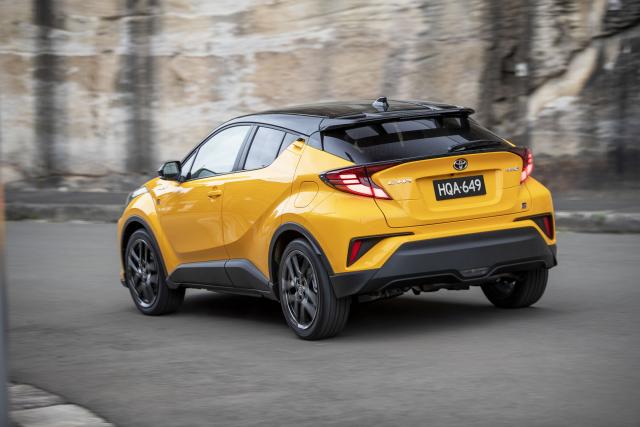By Chris Riley, Marque Motoring
Some people loathe the dramatic look of the Toyota C-HR. Personally, I really like design and have done since day one. So, I was mildly excited to hear there was now a GR version, the C-HR GR Sport — inspired by Toyota’s performance-focused GR models.
The key word, however, is “inspired” — because there’s no more power on offer and that is disappointing (you might feel differently).
STYLING
The GR Sport features a more aggressive front bumper and grille, with an aerodynamic lip, a bold lower grille, thick horizontal bar and revised fog light surrounds that sit lower than the standard model.
Sporty bits include larger 19-inch dark alloys with 225/45 series rubber, high-grade LED lighting front and rear, piano black finish for the rear lip spoiler, plus mirror caps and door garnishes.
Completing the look are white brake callipers with GR logos on the front, and GR emblems at the front, side, and rear.
A rationalised lineup now has three models, with a choice of two drivetrains and either front- or all-wheel drive.
The hybrid has the same setup as in the Prius, Corolla, Corolla Cross and Lexus CT hatch.
Pick the 1.2-litre turbo and you get a choice of front- or all-wheel drive. Opt for the hybrid, and it’s front-wheel drive only.
The GXL front-wheel drive hybrid, GR Sport comes only as a hybrid with front-wheel drive only. Though the GR Sport sits at the top of the tree it doesn’t get everything.
Standard kit includes sat-nav, dual-zone climate air, adaptive cruise, keyless smart entry and star, auto-dimming rear-view mirror, auto LED lights and wipers, electronic parking brake and a 4.2-inch colour driver display.
It dips out on powered driver lumbar adjustment, heated front seats and Nanoe Air Conditioning Technology – all standard with Koba. The latter is designed to send moisture-rich ions into the cabin to reduce odours, pollen and other allergens. It also reduces the dryness associated with standard air conditioning systems.
GR Sport is available in five colours, with the $450 option of a black roof with Crystal Pearl, Hornet Yellow or Feverish Red.
An 8.0-inch touchscreen fronts a six-speaker audio system, with AM/FM radio, Bluetooth, voice recognition, wired Apple CarPlay and Android Auto — but no DAB+.
ENGINES / TRANSMISSIONS
The powertrain consists of a naturally aspirated 1.8-litre engine, with 72kW and 142Nm, teamed with an electric motor that puts 53kW and 163Nm.
With a combined power output of 90kW, no mention of torque and an undisclosed kerb weight, performance is at best average.
The CVT does not provide “steps” or simulated gears like it does in petrol models, with drive and reverse settings plus B for engine braking.
SAFETY
A comprehensive five-star safety package encompasses seven airbags, a rear-view camera and Forward Collision Warning, Brake Assist and Autonomous Emergency Braking.
There’s also Lane Trace Assist, Auto High Beam, All-Speed Active Cruise Control and Pre-Collision Safety system with pedestrian detection, as well as Blind Spot Monitor, Road Sign recognition and Rear Cross Traffic Alert.
The latter misses out on auto braking and there’s no overhead parking monitor either — both of which come with Koba.
DRIVING
A GR Supra or GR Yaris it is not. GR Sport is quite clearly more about show than go.
It rides on larger flashier 19-inch alloys, with 225/45R19 Yokohamas, and 15mm lower sports suspension and sits 12mm closer to the ground.
Shock absorbers, spring rates and stabiliser bars have all been tweaked to reduce pitch and body roll, in the name of better handling.
A new centre brace has also been added to strengthen body rigidity and contributes to a more direct steering response.
There’s some talk of GR brakes, but apart from white calipers, no further information is offered, suggesting they are otherwise standard.
The sporty makeover continues inside with body-hugging, black leather-look sports seats and a leather-wrapped steering wheel.
There are also dark silver highlights around the instrument panel and door garnishes, piano black surrounds for the centre console and power-window switches, along with a GR-branded start button.
A diamond motif is repeated throughout the cabin, visible on the roof lining, overhead switches and interior light.
The dash features a pair of traditional analogue dials that flank a central information panel and while they are clear and easy to read — they lack the digital pyrotechnics of competitors.
Satnav fires up quickly and is easy to use, apart from the predictive text — but has an annoying habit of taking over the centre information panel where the digital speed is normally displayed. Cancelling a destination is also difficult.
With large rear pillars and a plunging roof line, the design leads to a back seat that is claustrophobic, offers limited legroom and does not have air outlets for passengers.
The hidden rear door handles are also difficult to use from some angles.
A small boot space hides a space saver spare.
All in all, however, the car looks amazing with its gleaming paintwork.
It would all be terrific if it just had more power to go with the more purposeful looks — more chutzpah to push through corners, requiring better handling and stopping power.
But the fact of the matter is that it doesn’t, therefore the handling enhancements are somewhat superfluous.
What’s more, the type of person who buys this car is unlikely to be from the boy racer fraternity and is hardly about to push the limits.
For the most part, the CVT tranny behaves itself, hiding the zoominess that usually marks CVTs.
Ride and handling are great, but the steering feels rubbery and the drive experience is far from engaging.
We have a long, steep hill near our neck of the woods that tends to sort the wheat from the chaff. You need a run up and it wasn’t kind to the C-HR. All of a sudden, under hard acceleration, it became quite harsh and noisy and the CVT went into overdrive, sounding like a lawnmower about to run out of petrol.
On a more positive note, fuel consumption is rated at a measly 4.3L/100km. We were using just 4.7 after more than 600km behind the wheel.
SUMMING UP
I keep wanting to like this car but let’s cut to the chase. There’s not much GRness, not much to get excited about — certainly no extra power. Frankly, I think for $37,165, the Koba 1.2-litre turbo with all-wheel drive offers a sportier package and you can spend the $500 you save on two-tone paint. Trust me, you won’t miss the sports suspension.
But be warned, with more than 60 accessories available to enhance your purchase — you’re liable to end up spending more than you had planned.
Come on Toyota, let’s have a real GR C-HR!
AT A GLANCE
MODEL RANGE
Toyota C-HR GXL 1.2-litre turbo, FWD, priced from $30,915
Toyota C-HR Koba 1.8-litre hybrid, AWD, priced from $35,165
Toyota C-HR GR Sport, 1.8-litre hybrid, FWD, priced from $37,665
Note: These prices do not include government or dealer delivery charges.










